Today I’m going to talk about light tents. It’s a great solution for small product photography that lets you achieve professional results with minimal effort and cost.
This article is a lot longer than it needs to be. I could do it in a single phrase:
“buy a light tent, use whatever lights you have or even just daylight, pay attention to detail”. But I hope you’ll enjoy the story and extra info that follows.
There’s an old business saw: “you can have it fast, you can have it cheap, you can have it good. Now pick any two.” Basically I like doing things the easy way, I’m a cheapskate and I want professional results. Generally you can’t achieve all of those things at the same time, but that’s what I want. A light tent goes a long way towards doing that for you.
I’ve had a light tent for a long time. I realized early that most good small product tabletop shots have 3 things going for them: soft, even lighting without intrusive shadows, a really clean background, and crisp focus. One way of achieving that is to invest in a brace of studio lights and light modifiers, build a stage with a custom sweep, and use a 4x5 view camera with associated stainless steel darkroom and nitrogen burst gaseous agitation system for developing consistent negatives. Another way is to put a DSLR on a tripod with a reasonable lens, get a light tent, and light it with whatever you happen to have on hand.
Now you realize that when I said that, my tongue was firmly implanted in my cheek because of course you’re not going to be shooting a national corporate ad campaign for Apple™ or Coca-Cola™ with that little setup, but how many of us do that? No, what we do is put a used MP3 player up on eBay (you know; one that’s fallen from a third floor window onto a concrete sidewalk and is smashed beyond repair. You list those as “may show some signs of wear and tear”! LOL), or take a picture of your watch because you’re bored and it’s snowing outside, or have some small products to show on your online small business site.
What is a Light Tent?
There are various other names for it, but basically it’s a cube, made of sturdy, white translucent nylon, usually framed by springy steel. aluminium or fibreglass poles or hoops so you can fold it down for storage.
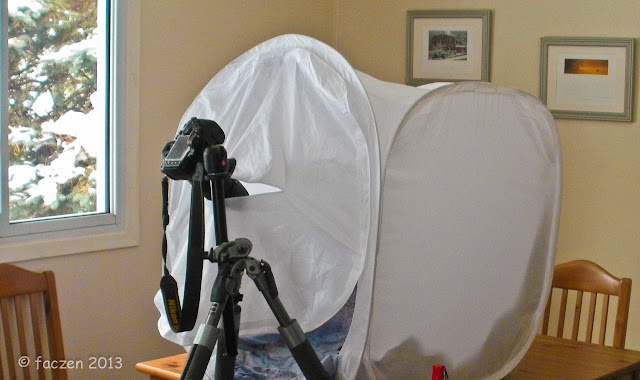 |
The panel with the slit in it that the camera is poking through is important when you're shooting objects that show shiny reflections. More below... |
(An aside here. I could not, for the life of me, figure out how to fold my tent down into its original package, which is a saucer shaped bag about 30cm in diameter. You have to hold it “just so”, twist it “like this” and lo and behold, it folds up! Once on a weekend photoshoot, I offered a prize to whomever could fold my tent up. Kathy looked at it for a second, picked it up and within 10 seconds, handed it back to me neatly folded. I begged her to teach me. I couldn’t get it. Then Rosa said, “look on YouTube”. “Nah, it wouldn’t be there...” wanna bet? There have to be 100 videos showing you how! Finally! I got it!)
When it’s open, the inside is completely white. Shine a light on one or more sides and you have a huge, even, light source. But because light filters through the sides, even putting it on a table near a window gives you great, soft illumination! You can also put a light inside it, pointed at a wall or the top, and again, a big, soft, even, shadow-free light source.
Where do you get one and how much are they?
Google is your friend. All the photo sources carry them: B&H photo,
Amazon Canada,
Amazon USA, your local camera store or... well, eBay! I bought mine on eBay, it came from Hong Kong in about 2 weeks and cost me $35 including shipping. You can get little ones even cheaper if all you shoot is small pieces of jewellery, for instance, but I bought one that was about 1m cubed. They also come big enough to shoot people in them!
The stores also sell kits including light stands, floodlights, etc. As much as $1000! Whatever floats your boat.
Light Sources
Now if you want the light to be really even, you should light up more than one side. The fact is, though, it doesn’t matter what you use for a light source. Studio strobes, remote Speedlights, continuous floodlights, or even ordinary light bulbs! You have to watch the colour temperature, of course but unless you mix them, you can easily compensate in the computer, often with one mouse click. My favourite light source is daylight from a nearby window and a single remote Speedlight. As I said, you can often get away with just one.
They don’t have to be particularly bright either. You did see where I said “tripod”, right? The watch shot here was a full 10 seconds. The camera kit shot was a short exposure shot with one Speedlight.
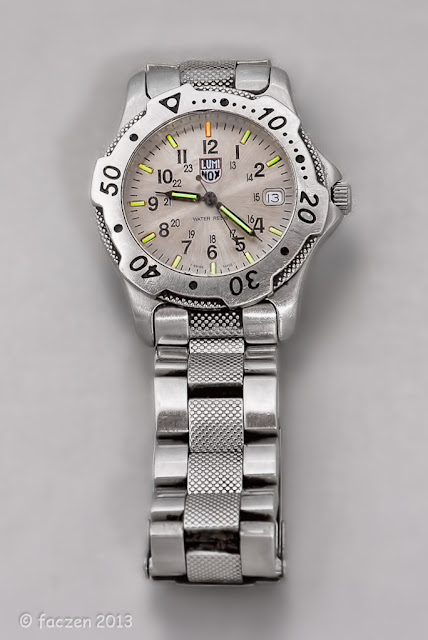 |
10 second exposure at f/8, ISO 100. Some light was from a Speedlight directly behind the subject, but most was from a flashlight shining directly on the watch, that I was waving around during the whole exposure.
Here's a good question, though. Why is the second hand visible? It was not in one place long enough to be lit by the flashlight, but the Speedlight shouldn't have picked it up either because it was not shining on the watch face! It's a mystery to which I do not have a good answer. |
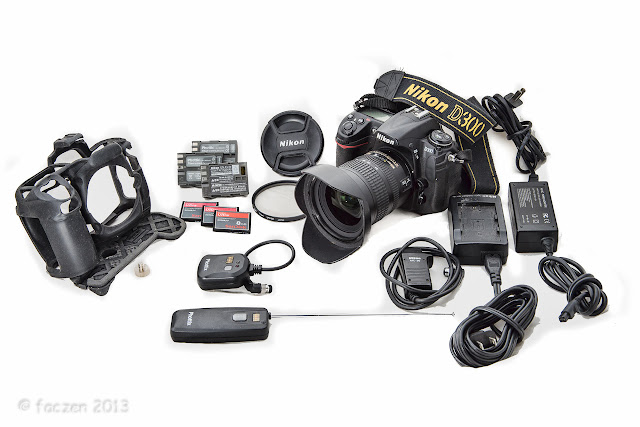 |
1/125 second at f/14, ISO 400. In this case, the subject stuff was sitting directly on the white cloth sweep. I cranked the whites up in Lightroom and added some detail enhancement in Photoshop/Topaz. This D300 kit is still for sale as I write this, contact me if you're interested in a great deal. |
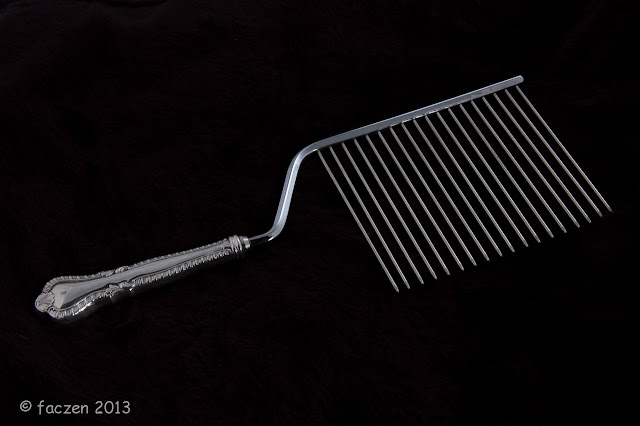 |
I admit that this shot used multiple light sources. It didn't need to, though. This was done back when I had a full set of studio strobes and I lit both sides and the top of the tent with them. The background was a furry acrylic thing I happened to have around. |
It's important to be able to move the Speedlight around, so you need to get it off the hotshoe on your camera. Especially if you're shooting with just the one light, where you put it and where you aim it affects your shot tremendously.
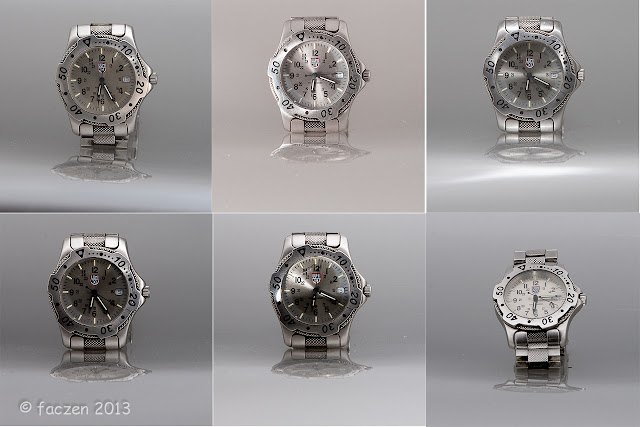 |
Here are 6 different exposures of my watch lit ONLY by the Speedlight, but in different spots. The reflections underneath are from the plastic sweep that I describe in the next section. |
Backgrounds
You want your subject to be evenly lit, but you also want it to be on a clean background. White, black, coloured, patterned, reflective... it’s easy to achieve all of those things with a sweep. That’s a technical term for a curved, seamless background that starts above your image frame and ends below it. Your subject can sit on it or be suspended in front of it and it can be as invisible as you want.
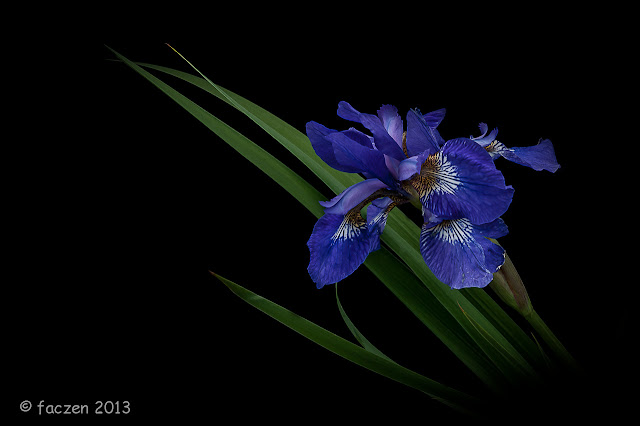 |
On a black background (obviously!). I shot this outdoors, with the light tent in the shade not in direct sunlight. I used a little flash fill to bring out some textures and details. |
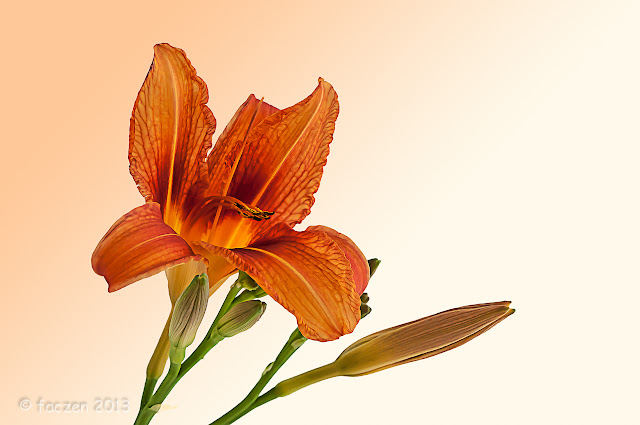 |
Here's another flower shot, same setup except a white background. I sampled the orange of the flower in Photoshop and toned the background with a tint of it. The Speedlight was in the back so I could get light shining through the petals. |
Most light tents come with a few different sweeps. Mine had a white one and a black one but I used a variety of different pieces of cloth for the same purpose. The tent has little Velcro tabs you can attach the sweep to, but in a pinch, a couple of ordinary clothespins will do.
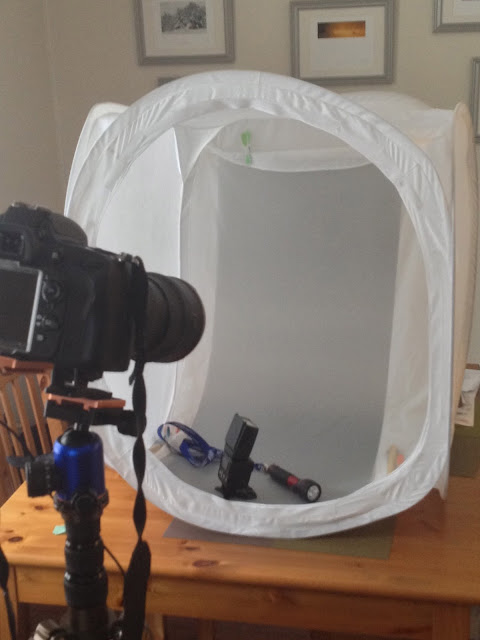 |
This is that piece of plastic I describe in the text, just lying in the tent. |
Remember I said I was lazy? If your background is wrinkled or dirty, you may need to spend some time in Photoshop to remove the shadows, marks and creases. So try to keep them clean and use a wrinkle-free material. Or if you strongly light the background behind your subject — which you can also do from outside the tent with another light of some description — all those things get blown away. The other extreme is to use a black background and try to shade it from the light.
Sometimes you want your subject sitting on a reflective surface. That adds tremendously to the 3-dimensionality of your picture. What I did was to go to a local sign shop and had them make up a translucent, flexible piece of plastic. They used a neutral gray for me and I paid $30 for a meter-long piece. Two Velcro tabs on the top and a little stand underneath — you can make it from wooden dowels or wire hangers or even old (clean!) chopsticks, and you’re done. An even better solution: use a Tupperware™ container as a support underneath. By raising the subject up, you can now light it from below as well!
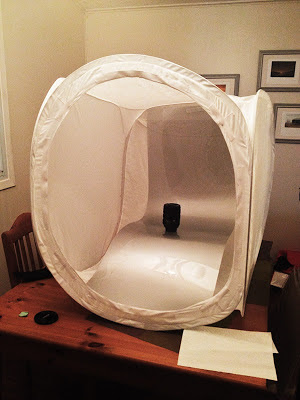 |
The plastic sweep is sitting on top of a Tupperware container. I put a Velcro™ strip at the very top to hold it in place. |
One thing you need to watch out for are reflections of you and your camera when shooting shiny objects. Most of the light tents come with a shoot-through panel with a slit for the lens. I can’t find mine right now but an old bedsheet and a pair of scissors should fix that in short order!
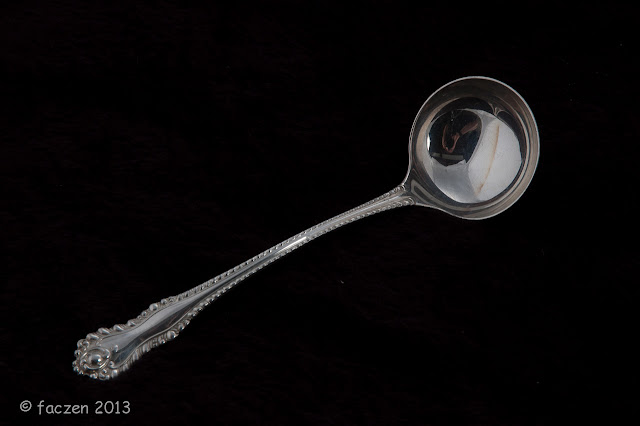 |
What happens if you shoot shiny reflective things without bothering to hang the shoot-through panel. Look at the reflection in the bowl of the spoon! |
Example
Here’s a shot I did this week because there was a competition category on the TIF forum called, “jewellery” and I didn’t have a lot of time to shoot! In fact, the competition ended at midnight that day, and I got home just before 9pm, tired after a 2-hour drive, and hadn’t yet eaten. I had to clean off the dining room table, set up the tent and shoot. I was basically done by 9:10 but I got carried away and kept going for a few minutes more because I wanted to try something.
What I did was to stick the watch on my plastic background using green removable tape. I didn’t feel like changing lenses so I just used the 70-200 that was on the camera, and on a tripod, with VR turned off, I stopped down to f/8, put my Speedlight beside the tent and took a shot or two. Done. However I wanted to blow out the background, so I moved the Speedlight directly behind the tent (it still sensed the controlling flash from the pop-up) and used room light to illuminate the tent. Ugly, because the room light was tungsten.
My Luminox™ watch glows in the dark. It has little radioactive Tritium capsules that are really bright, the same ones used on the night sights on a Glock™ pistol. My goal was to see them in the picture, so I didn’t want to do a lot of front illumination. So I locked the shutter open for 10 seconds, went and got a little LED flashlight that’s more daylight coloured, and waved it around at the watch. The strobe was all done doing its thing after a few milliseconds and I could play with light painting all I wanted after that.
Here’s another lesson: pay attention to detail and (a) you’ll have better results and (b) you’ll have to spend less time fixing things later in the computer. This applies to all kinds of pictures, not just still life and product shots.
Here’s a before-and-after. On the left is the original image right out of the camera, on the right, the finished shot. It took me about an hour in Photoshop and Lightroom to make the following edits:
The watch was dirty. I should have taken a minute to clean it before shooting it. Look at the bottom of the bracelet on the right side and in the middle.
- There was a scratch on the crystal at 11:00. I had to clone the “1’s” from the 10:00 and remove the scratch with the clone and content-aware healing brush tools.
- There was a bit of glare at top left which I burned back and cleaned up.
- Contrast adjustment on the little date window and I painted out some dust and dirt here and there. Not sensor dust, "dirty old watch dust".
- I increased the saturation to bring out the colours of the light capsules, then used a masked layer in Photoshop to limit the increased saturation to those spots. I reduced the overall saturation because there was a bit of a pink glow (probably caused by the tungsten lights in my living room that intruded in the 10-second exposure).
- The bracelet and watch weren’t completely straight. I used Puppet Warp to straighten them. I could have done even more but I figured it was good enough.
- Background spot removal. I need to clean my sensor again... then I opened a fresh masked layer and used a Gaussian Blur to soften out any background artifacts. Again, I could have done a bit more work on this.
 |
1:1 blowup of the image. Amazing how much detail is visible. Of course some of that is due to the excellent sensor in the D600. I shot this with the 70-200mm lens from quite far away. A macro lens would have made it spectacular. |
So the shot and setup took less than half an hour, the Photoshop stuff longer because I didn’t pay enough attention in setup, and because I was having fun playing with it!
Something completely different!
Here I used the light tent for a completely different purpose: I used it as a flash modifier, in other words, as a light source!
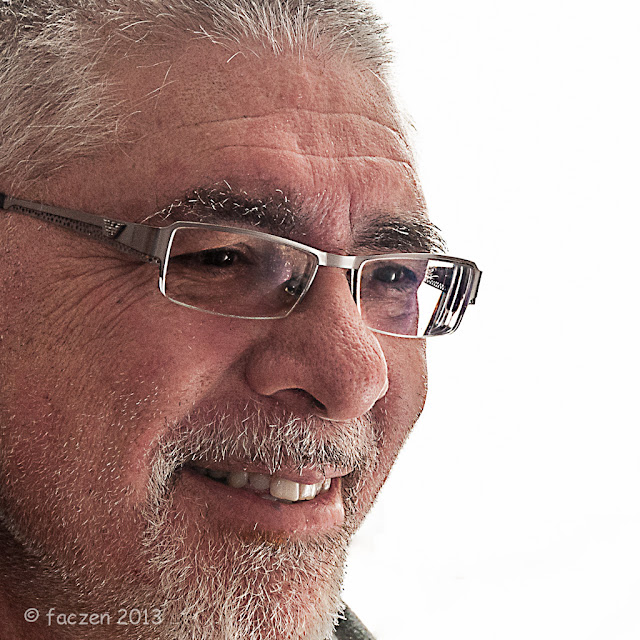 |
The glowing white background that you see is my Speedlight shining through the light tent from behind. Obviously I'm not inside it. I had a silver dish reflector off to camera right that threw light on the face and the Speedlight was the ONLY illumination! |
Summary
A light tent is a great investment. I’ve even used it as a soft backlighting source for this Avatar shot of me (one light source, my Speedlight directly behind it, and a reflector in front of me to camera right to light the face). How else can you get a custom, professional looking lighting setup that pops up in no time and costs you under $50?
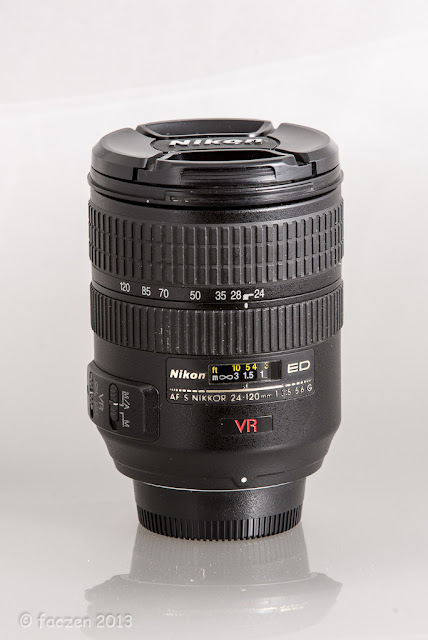 |
My well-used 24-120mm lens. The setup is shown in the iPhone shot a few pictures up, with the lens sitting on the sweep. The Speedlight is about level with the lens and pointing through the right hand side wall at about a 45° angle. You can see every fleck of dust, every scratch and wear mark on the lens. Not necessarily a good thing if this were a shot intended for a sales listing on eBay or Kijiji! |
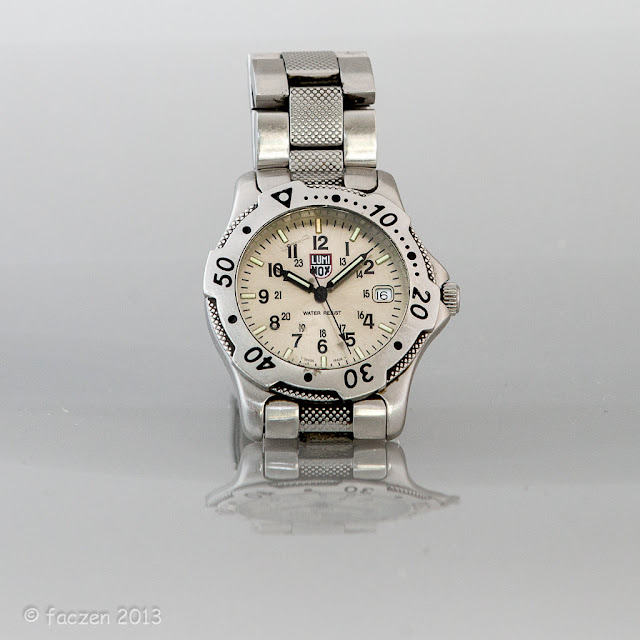 |
One more picture. I'm sure you're tired of looking at my watch. But this one was shot at, well, about 10:08 am using the ambient light from a west-facing window and NO flash. I have not cleaned it up at all: it's just as it came out of the camera, except for cropping, exposure adjustment and a little clarity tweak in Lightroom. Look at the great even lighting! |
I’d enjoy seeing some of your shots... send me some links and I’ll append them at the bottom of this article.
— 30 —


















